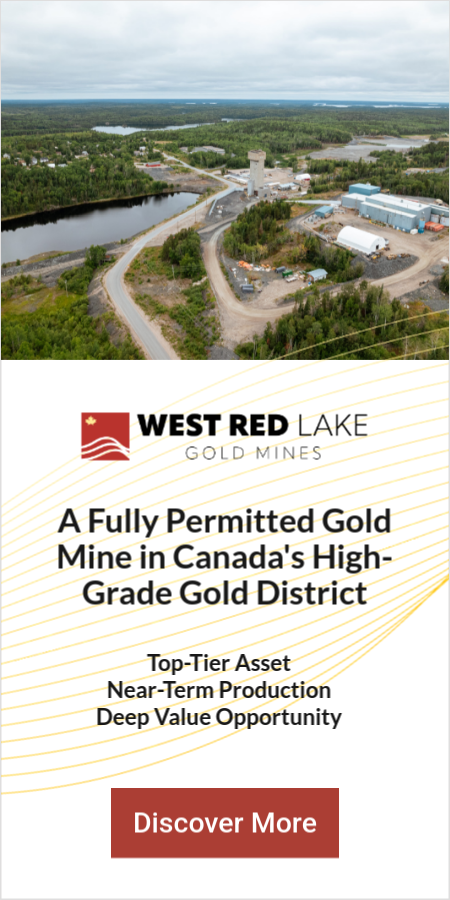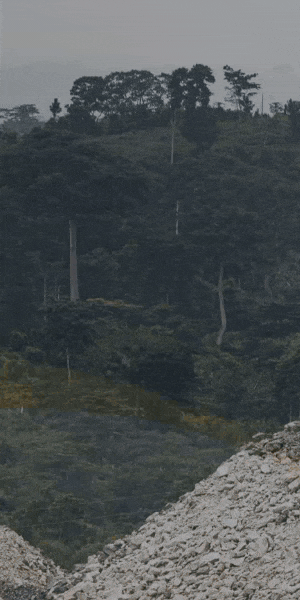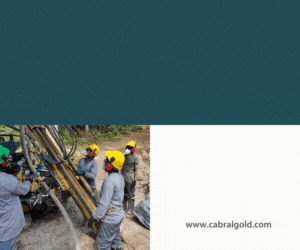Madsen Ramp-Up Gains Momentum & Signals a Potential Re-Rating Catalyst for West Red Lake Gold Mines

West Red Lake Gold reports 24% production increase at Madsen Mine, advancing toward Q1 2026 commercial production with improved infrastructure and experienced team.
- West Red Lake Gold's November 18, 2025 update shows a 24% month-over-month increase in mined ore production between September and October 2025, underscoring meaningful progress in the Madsen Mine ramp-up.
- Key infrastructure, waste rock storage, new scoops, haul truck delivery, and pending shaft activation, is reducing costs and improving ore movement capacity, advancing the mine toward commercial production in early 2026.
- Strengthened site leadership, including senior hires from Wesdome, Kirkland Lake, and Newmont joining between Q2 and Q4 2025, materially reduces operational and execution risk.
- Madsen's high-grade profile (8.2 g/t), 95.7% recoveries, and C$496 million NPV position WRLG as a potential new mid-tier gold producer in the Red Lake district.
- As WRLG approaches stable production levels in early 2026, improving operational performance and declining cost structure may drive a market re-rating along the development-to-producer curve.
Why the Madsen Update Matters for Investors
West Red Lake Gold's November 18, 2025 operational update delivers tangible evidence of execution at a critical inflection point. The company reported a 24% month-over-month increase in mined ore production between September and October 2025 at its Madsen Mine, a metric that moves beyond forward guidance to demonstrate operational capability during the ramp-up phase. For investors evaluating emerging producers, this data point carries significant weight. The transition from developer to producer represents the highest-risk segment of the Lassonde Curve, where execution failures destroy shareholder value and successful ramp-ups generate substantial re-ratings.
The Red Lake district in Ontario has produced over 30 million ounces of gold since discovery, establishing the geological framework that underpins Madsen's high-grade resource. West Red Lake Gold's progress toward commercial production in early 2026 positions the company within a narrow cohort of new North American gold producers emerging during a period of elevated gold prices and institutional capital rotation toward cash-generating assets. The production increase reflects the impact of specific infrastructure projects completed in recent months, including underground waste rock storage capacity and equipment fleet expansion.
The update matters because it provides measurable proof of operational competence at precisely the moment when market participants distinguish between developers who can execute and those who cannot.
The Macro and Sector Context: Why New Producers Matter Now
The investment landscape for gold equities has shifted decisively toward companies demonstrating near-term cash flow visibility. Institutional capital allocators, facing pressure to deploy capital efficiently within constrained budgets, prioritize emerging producers over earlier-stage developers. Analysis from CapIQ as of October 2025 shows that new and growing gold producers outperformed major indices by 154% on average, reflecting market recognition of companies transitioning from development to production. This outperformance stems from multiple compression as markets re-rate assets from Enterprise Value to Resource metrics toward Enterprise Value to EBITDA multiples, reflecting cash generation rather than geological potential.
West Red Lake Gold's ramp-up timeline aligns with this structural trend. The company's path to commercial production in early 2026 positions it to capture capital flows seeking de-risked exposure to gold price appreciation through operational leverage rather than exploration optionality.
High-Grade, Low-Cost Producers as a Strategic Hedge
Underground operations with high-grade resources deliver superior margin resilience across commodity price cycles. Madsen's diluted mining grade of 8.2 grams per tonne gold, combined with 95.7% metallurgical recoveries, creates a cost structure that maintains profitability across a wide range of gold price scenarios. High-grade mines benefit from lower tonnage requirements to generate equivalent revenues, reducing energy consumption, processing costs, and capital intensity per ounce produced.
This operational profile becomes particularly valuable during periods of input cost inflation or gold price volatility. The spread between high-grade and low-grade producers widens materially when diesel, explosives, and labor costs rise, as high-grade operations process significantly fewer tonnes to achieve production targets.
Scarcity Value in North American Permitted Gold Mines
The supply of new, fully permitted underground gold operations in Tier-1 jurisdictions has contracted materially over the past decade. Permitting timelines in Canada have extended, M&A activity has consolidated existing producers, and capital constraints have delayed development projects. This scarcity creates positioning value for companies like WRLG that inherit legacy infrastructure and expedited permitting pathways.
Madsen as a High-Grade, Tier-1 Asset
Madsen's Mineral Resource Estimate supports a diluted mining grade of 8.2 grams per tonne gold, positioning it favorably among North American underground gold operations. Metallurgical test work confirms 95.7% gold recovery through conventional cyanide leaching, eliminating the need for complex or capital-intensive processing routes. The underground mining method, primarily long-hole stoping, allows selective extraction of high-grade zones while managing dilution through contemporary mine planning techniques.
The Rowan Property as a Strategic Future Feed
The adjacent Rowan property, owned by WRLG within the Red Lake district, offers high-grade mineralization that supports long-term production beyond Madsen's initial mine life. Company guidance targets combined production levels exceeding 100,000 ounces per year by 2028 through production growth at Madsen and advancing Rowan, reducing single-asset risk and extending the company's production profile.
Operational Progress: The Ramp-Up Turning Point
West Red Lake Gold reported that mined ore production increased 24% between September and October 2025, representing the most significant operational data point in the November update. This improvement reflects the culmination of infrastructure projects and equipment additions implemented throughout Q3 and early Q4 2025. The production increase demonstrates that site-level changes are translating into measurable throughput improvements, validating the company's capital allocation decisions during the ramp-up phase.
The 24% improvement carries particular significance because it occurs during the ramp-up phase when operations typically experience volatility as systems stabilize and workforce productivity improves. Since mine restart in May 2025, WRLG has produced 12,800 ounces through Q3, with consistent month-over-month gains indicating that the operation is moving through the learning curve and reducing the duration of elevated costs and operational instability that characterize early production.
Gwen Preston Vice President of Communications described how the team has approached this ramp-up period and the path to commercial production:
"We started the mine up in May of this year now we're in the ramp up phase… We're increasing the amount we're pulling out of the mine, we're adding more trucks, we're getting this thing up to speed, with a goal of getting ourselves to commercial production sometime in the next few months".
Waste Rock Storage Program: Cost and Efficiency Impact
The underground waste rock storage program represents a critical infrastructure investment that addresses one of Madsen's primary operational bottlenecks. By storing waste rock in historic underground stopes rather than hauling to surface facilities, WRLG has freed trucking capacity and reduced cycle times for ore haulage. The program was initiated in mid-September 2025 and has contributed directly to the subsequent production improvements.
The operational impact extends beyond simple logistics. Reduced trucking requirements lower diesel consumption, decrease equipment wear, and improve scheduling flexibility. These factors are expected to reduce All-In Sustaining Costs and improve continuous ore flow to the processing facility, minimizing mill downtime and maximizing throughput.
Preston underscored that the restart strategy hinged on getting this efficiency equation right before committing to sustained production:
"We weren't interested in putting the mine into production until we knew that we could mine and move material efficiently.”
Tonnage Tracking Toward Commercial Levels
Daily tonnage rates at Madsen are tracking toward the commercial production threshold targeted for early Q1 2026. The company expects to declare commercial production when Madsen is running consistently with all equipment in place, producing expected tonnage, and with costs aligned to projections. This stability matters because it signals the transition from development-stage valuation metrics toward producer-stage metrics, typically accompanied by multiple expansion as cash flow visibility improves.
Preston outlined the operational conditions the team is working toward:
"We expect to declare commercial production when we have Madsen running the way. That means you have all of your equipment in place, you have your mine producing its expected tonnage… then your costs are coming in where you expected them to be. That's the process that we're in right now".
Infrastructure and Equipment: Building the Platform for Steady-State Operations
WRLG took delivery of three four-yard scoops during the first half of Q4 2025, designed to improve mucking efficiency and reduce cycle times in stope production areas. The additional scoops increase equipment availability and reduce dependence on any single piece of equipment, improving operational flexibility. The company expects delivery of its final 42-tonne haul truck in the coming weeks, completing the fleet required for commercial production rates.
Shaft Activation and Cost Impact
The planned activation of the shaft skipping system represents a significant cost reduction initiative in WRLG's near-term operational plan. The company expects to start moving 350 tonnes per day up the shaft in November 2025, at approximately 10% of the cost of trucking material to surface via the ramp. The shaft was refurbished above the 12th level and is currently awaiting skip and scrolls. This cost differential stems from the inherent efficiency of vertical hoisting compared to diesel-powered truck haulage over multi-kilometer ramp systems. The shaft activation is expected to materially reduce diesel consumption, lower equipment maintenance requirements, and decrease labor hours dedicated to ore haulage.
Maintenance Shop and Reliability Metrics
Components for construction of a maintenance shop arrived on site as of November 18, 2025. On-site maintenance capacity directly influences equipment availability, a key performance indicator in underground mining operations. The maintenance shop's completion is expected to support preventive maintenance scheduling and rapid response to equipment failures, reducing unplanned downtime and contributing to the operational predictability that markets reward during the transition to commercial production.
Strengthening the Operating Team , A Major Reduction in Execution Risk
West Red Lake Gold has materially strengthened its site management team with senior hires from established producers. Sean McCormack joined as Mine General Manager in Q2 2025, bringing extensive experience from Wesdome Gold Mines and Kirkland Lake Gold. Bright Asamoah joined as Chief Engineer in September-October 2025, bringing production optimization experience from Newmont Corporation. James Armstrong serves as Mill Manager, while William Curry oversees operations as Senior Operations Manager, both joining in the September-October 2025 timeframe.
Preston emphasized the deliberate focus on building an operating team with mine-building credentials:
"He [Shane Williams, President and CEO] very pointedly built a management team that knows how to build and operate mines and that's truly our unique strength. It's not common in the world of junior mining to have that skill set and that's the skill set that we plan to deploy to create value".
The recruitment of experienced personnel reflects the company's operational strategy and asset quality, addressing execution risk during the critical ramp-up phase where management capability directly influences outcomes.
Economics and Financial Position: Understanding the Valuation Case
Madsen's Prefeasibility Study dated January 7, 2025 established baseline economics that continue to inform the investment thesis. The PFS outlined a Net Present Value of C$496 million using a US$1,680 per ounce gold price assumption, an Internal Rate of Return of 42% post-tax, and average annual Free Cash Flow of C$94 million. All-In Sustaining Costs were projected at US$1,681 per ounce over the life of mine. With gold prices materially above the PFS assumption, sensitivity analysis suggests substantial upside to the original projections.
Tax Advantages and Jurisdiction
WRLG holds substantial tax credit pools that will create essentially zero tax paid in the short term, materially improving Free Cash Flow generation during initial production years. Ontario's regulatory framework and political stability position Madsen within a Tier-1 jurisdiction, factors that institutional investors prioritize when allocating capital.
Key Near-Term Catalysts , What Investors Should Watch
Commercial production declaration in early Q1 2026 represents the single most significant near-term catalyst, triggering a fundamental shift in how markets value the company. Shaft activation expected in November 2025 will provide immediate validation of projected cost improvements and operational efficiency gains. The arrival of the final 42-tonne haul truck completes the primary equipment fleet, with subsequent updates focusing on equipment availability and utilization metrics.
External Risks and Considerations
Underground mining inherently carries geological and geotechnical risks that can impact production rates and costs. Dilution from wall rock contact, variations in vein width, and structural complexity can reduce realized grades below resource estimates. Mining input costs remain subject to inflation pressures across diesel, explosives, consumables, and labor. Despite positive progress indicators, ramp-up phases remain high-risk periods where equipment failures, workforce turnover, or unforeseen technical challenges can disrupt production. WRLG's strengthened management team mitigates execution risk materially, as experienced personnel anticipate and resolve issues more effectively.
The Investment Thesis for West Red Lake Gold
- High-grade underground mines with strong recoveries offer superior margin resilience in volatile gold markets, as lower tonnage requirements per ounce produced reduce exposure to input cost inflation and energy price volatility.
- Tier-1 jurisdictions like Red Lake attract institutional capital flows seeking permitting certainty, political stability, and ESG compliance frameworks that align with portfolio mandates increasingly focused on jurisdictional risk mitigation.
- New producers have demonstrated meaningful outperformance relative to major gold indices, with CapIQ data showing 154% average outperformance as of October 2025, driven by rapid multiple expansion as cash flow visibility improves and valuations transition from Enterprise Value per Resource ounce to Enterprise Value per EBITDA metrics.
- WRLG's operational progress, including the 24% production increase between September and October 2025, operational waste rock storage program, and planned shaft activation, indicates a meaningful reduction in execution risk at the inflection point where markets differentiate between developers who execute and those who fail.
- Strengthened site management with deep underground credentials from Wesdome, Kirkland Lake, and Newmont materially increases confidence in WRLG's ability to achieve commercial production and transition to a mid-tier growth profile capable of sustaining production above 100,000 ounces annually by 2028.
Why the Madsen Update Represents a Pivotal De-Risking Point
West Red Lake Gold is executing a transition from high-risk developer to emerging producer within one of North America's premier high-grade gold districts. The November 18, 2025 operational update provides tangible evidence that execution risk is declining at the precise moment when market participants assign premium valuations to companies demonstrating operational competence during ramp-up phases. The combination of measurable production improvements, strategic infrastructure investments, and materially strengthened site leadership positions WRLG for potential re-rating as commercial production approaches in early 2026. The 24% month-over-month production increase, operational waste rock storage program, pending shaft activation, and senior management additions collectively represent systematic execution against a detailed operational plan designed to achieve commercial production with predictable costs and sustainable throughput. For investors evaluating emerging gold producers, WRLG's update provides the operational proof points necessary to reduce risk premiums and anticipate the valuation transition from development-stage to producer-stage multiples.
TL;DR
West Red Lake Gold's November 18, 2025 operational update demonstrates significant progress at its Madsen Mine, with a 24% month-over-month production increase between September and October 2025. The company has strengthened site management with senior hires from Wesdome, Kirkland Lake, and Newmont, while completing critical infrastructure including waste rock storage and equipment fleet expansion. With the shaft activation planned for November 2025 and commercial production targeted for early Q1 2026, WRLG is positioned to transition from developer to producer within one of North America's premier high-grade gold districts. The combination of 8.2 g/t grade, 95.7% recoveries, and operational execution positions the company for potential market re-rating as it achieves stable production.
FAQs (AI-Generated)
Analyst's Notes




Subscribe to Our Channel
Stay Informed



































